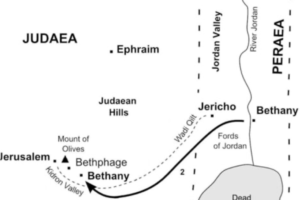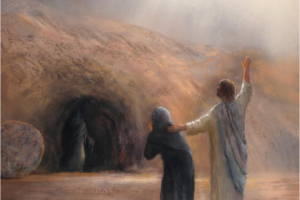
Lazarus is ill. Hey, who is Lazarus? Lazarus is the one whom Jesus loved. It says more than a handful of times. Don’t we know that John’s Gospel denotes the one whom Jesus loved. But that was tradition, the scholars in the turn of the 2nd C who declared him as that, albeit he is never named.

12+ Disciples
Jesus had many disciples: his inner 3 (Peter, James and John), and then the remaining 9 as core disciples. But there were the 70 or 72 disciples whom he also sent out, and myriad of woman (Mary, Martha, Joanna, Susan and many others) (Luke 8:3) who were part of the ministry and financing it all.
When we heard this passage we might have pushed back and said if
Jesus could bring back to life Lazarus what about my loved one?
Do we cry?
Three times in the Gospels, Jesus cries or actually weeps. The latter is more a body wrenching sob, do we recognise that?
Jesus wept over Jerusalem (Luke 19:41); Jesus wept at the cross when he exclaimed My God, My God why have you forsaken me?; and Jesus wept at the news of the death of his friend Lazarus.
In this passage (John 11:1-45) we hear that Jesus is at Bethany, by the River Jordan, near to where John baptised him at first (John 2). Jesus gets wind that Lazarus, Mary & Martha’s brother, is ill, very ill.
Here, we have to take stock about where we are reading – this is John’s Gospel, written around 90-110 CE, some 60-80 years after the resurrection of Jesus. This Gospel is unlike the other Gospels which show Jesus to be one who speaks in parables, keeps all that he is doing a secret; whereas in John’s Gospel, recall how it starts. Jesus is the word of God, an adult, not a child in a manger. Jesus can do amazing miracles and the Gospel contains long conversations with Nicodemus, Photoni (Woman at the Well), Pilate etc : He knows what other people are thinking. John’s Gospel highlights that Jesus is divine.
But opposition is in the way
Jesus is warned that there is opposition waiting for him if he goes to Judea: seems this could be more than a long term issue but something which is very topical.
Darkness and Light…
The disciples remonstrate with Jesus: don’t delay, go now. Jesus mentioned that there are times of day and night. Seemingly superfluous to this issue but it is key. The author of the Gospel has been using this theme throughout: Nicodemus arrives in the dark, the woman at the well arrives at Midday, the blind beggar can’t see but then can, the Pharisees have vision but can’t see what Jesu sis saying: light and darkness. Thomas, bless him, says let’s all die then. If Lazarus is dying, theirs is darkness, but if there’s life, he will be in the light. Let’s see.

The journey to Bethany in the Jordan to Bethany near Jerusalem is about 20 miles, a day’s trip perhaps. Now Lazarus has been dead now for 4 days albeit Jesus waited for 2 days. Why delay?
Jesus eventually arrives to find Mary & Martha, and many others in despair. They sent the message to Jesus without expecting any return to life of their brother. Martha ran out and “if you only had been here” They had a discussion for some quite time as Mary and the others had now followed Martha to find Jesus. As Mary arrives she is crying profusely, Jesus is said to be deeply angered, emphasising the intensity of Jesus’ emotions.
Jesus is told “Come and See” where they had taken the dead Lazarus. “Come and See” is the phrase Jesus used to find new life to his disciples, the locals use “Come and See” to witness death.
Locals deride Jesus “you healed a blind man, but couldn’t keep Lazarus from dying”.
The Tomb
As they approach the tomb, Jesus still angry, demands that the stone is rolled away. They roll away the stone to reveal not a stinking body but Lazarus, wrapped in graveclothes. From the darkness Lazarus enters the light. Unwrap him says Jesus. The community need to be told.

hope is emerging?
What have we heard?
It was Grief: in the Denial in Jesus waiting to leave; Anger in Jesus is deeply disturbed; Bargaining with the sisters protesting that Jesus could have got here sooner; Depression with Jesus weeping; and Acceptance in that some believed in Jesus.
When Jesus wept he was weeping for the nation, for the people, for the sisters and for Lazarus.
This passage is more than about the raising of Lazarus, but about the movement from darkness to light, from the inner depths of the tomb to emerging with Jesus.
Our Stone
The stone imprisoning us could be due to a failed relationship, a lack of hope, that our happiness would never return. We also have a huge stone which blocks our way: it blocks the way to love, to feel. It prevents us from moving from this time of feeling dead.
As one put it, “where we put a full stop, God puts a comma” .
Be prepared to be surprised
So as we move through this final week of Lent and into the great 3 days of Jesus’ own death and resurrection. Don’t assume you already know how the story goes. Be surprised.
Not taken in by the story we recall, but surprised by empty tombs, surprised by the thing you never saw coming. “Be surprised by how you can have something or someone taken from you which you thought you couldn’t live without and then finding yourself living without them anyway. Surprised that you tear up when receiving Communion and that oh my gosh, you aren’t afraid of that one thing you used to be and surprised that maybe you can actually have a relationship with your body that is not negative anymore and surprised that a relationship you thought was dead is not and that maybe everyone doesn’t hate you after all. Surprised, as we say, at empty tombs and the suddenness of dawn”.
Look for that journey from darkness into the light.
I found the dialogue interesting and I enjoyed it